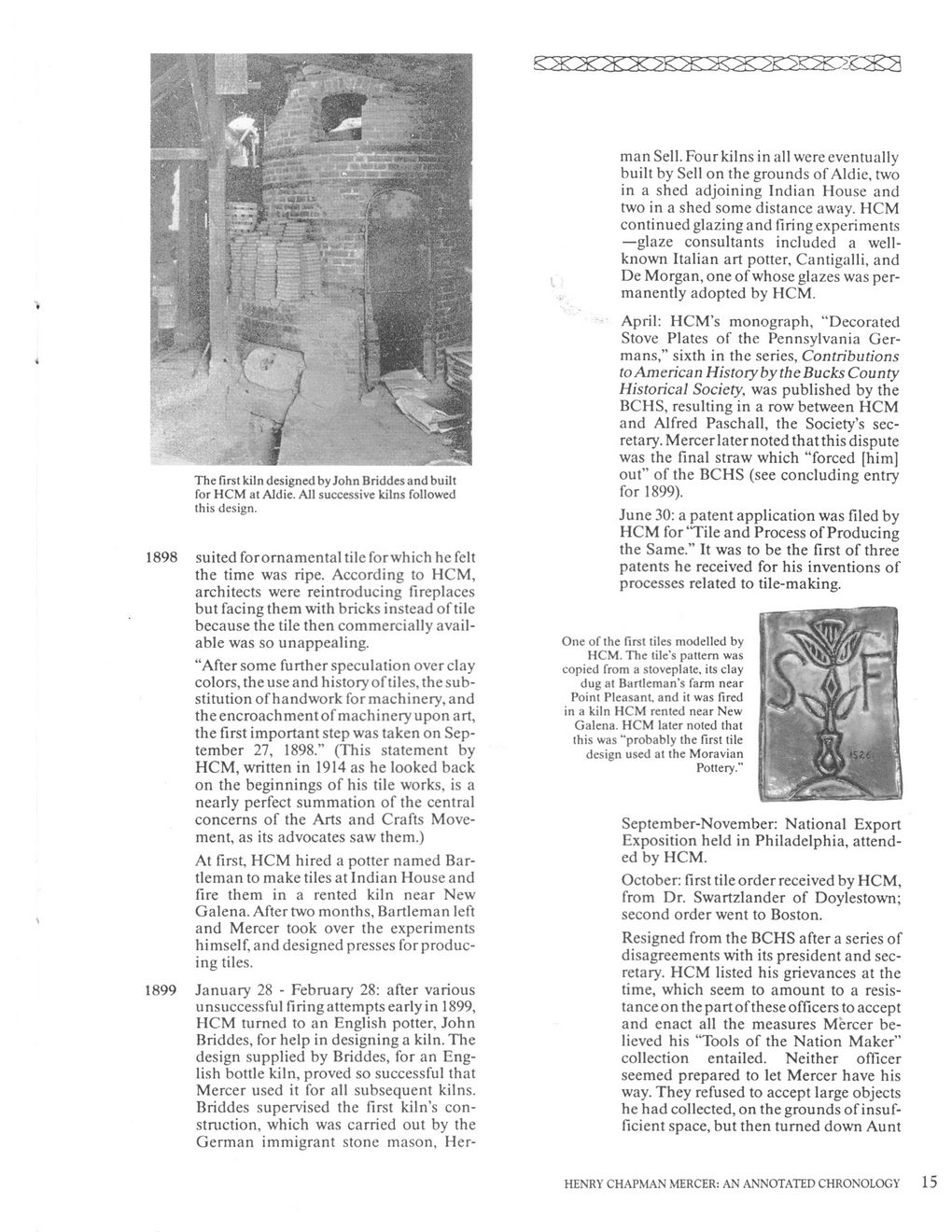This text was obtained via automated optical character recognition.
It has not been edited and may therefore contain several errors.
The first kiln designed by John Briddes and built for HCM at AJdie. All successive kilns followed this design. 1898 suited forornamental tile for which he felt the time was ripe. According to HCM, architects were reintroducing fireplaces but facing them with bricks instead of tile because the tile then commercially available was so unappealing. “After some further speculation over clay colors, the use and history of tiles, the substitution of handwork for machinery, and the encroachment of machinery upon art, the first important step was taken on September 27, 1898.” (This statement by HCM, written in 1914 as he looked back on the beginnings of his tile works, is a nearly perfect summation of the central concerns of the Arts and Crafts Movement, as its advocates saw them.) At first, HCM hired a potter named Bar-tleman to make tiles at Indian House and fire them in a rented kiln near New Galena. After two months, Bartleman left and Mercer took over the experiments himself, and designed presses for producing tiles. 1899 January 28 - February 28: after various unsuccessful firing attempts early in 1899, HCM turned to an English potter, John Briddes, for help in designing a kiln. The design supplied by Briddes, for an English bottle kiln, proved so successful that Mercer used it for all subsequent kilns. Briddes supervised the first kiln’s construction, which was carried out by the German immigrant stone mason, Her- man Sell. Four kilns in all were eventually built by Sell on the grounds of Aldie, two in a shed adjoining Indian House and two in a shed some distance away. HCM continued glazing and firing experiments —glaze consultants included a well-known Italian art potter, Cantigalli, and De Morgan, one of whose glazes was permanently adopted by HCM. April: HCM’s monograph, “Decorated Stove Plates of the Pennsylvania Germans,” sixth in the series, Contributions to American History by the Bucks County Historical Society, was published by the BCHS, resulting in a row between HCM and Alfred Paschall, the Society’s secretary. Mercer later noted that this dispute was the final straw which “forced [him] out” of the BCHS (see concluding entry for 1899). June 30: a patent application was filed by HCM for “Tile and Process of Producing the Same.” It was to be the first of three patents he received for his inventions of processes related to tile-making. One of the first tiles modelled by HCM. The tile's pattern was copied from a stoveplate, its clay dug at Bartleman’s farm near Point Pleasant, and it was fired in a kiln HCM rented near New Galena. HCM later noted that this was “probably the first tile design used at the Moravian Pottery.” September-November: National Export Exposition held in Philadelphia, attended by HCM. October: first tile order received by HCM, from Dr. Swartzlander of Doylestown; second order went to Boston. Resigned from the BCHS after a series of disagreements with its president and secretary. HCM listed his grievances at the time, which seem to amount to a resistance on the part of these officers to accept and enact all the measures Mercer believed his “Tools of the Nation Maker” collection entailed. Neither officer seemed prepared to let Mercer have his way. They refused to accept large objects he had collected, on the grounds of insufficient space, but then turned down Aunt HENRY CHAPMAN MERCER: AN ANNOTATED CHRONOLOGY 15

Bucks-Mont, Pennsylvania Bucks County Hist Soc - Henry Chapman Mercer (17)